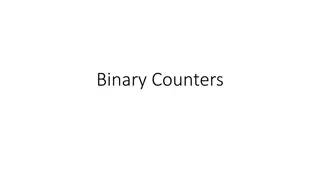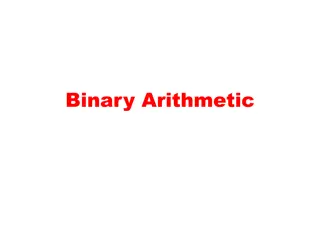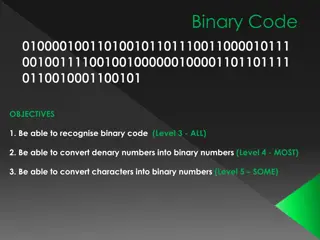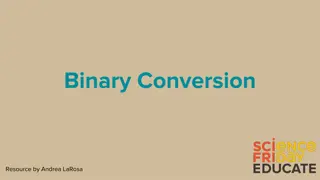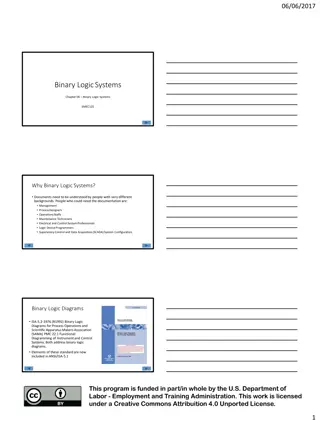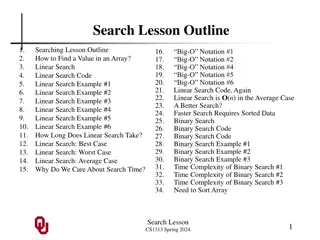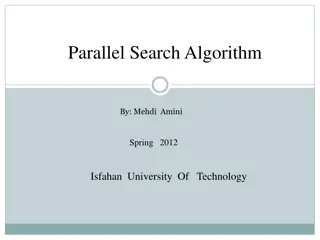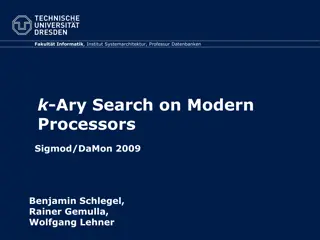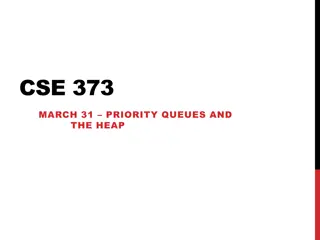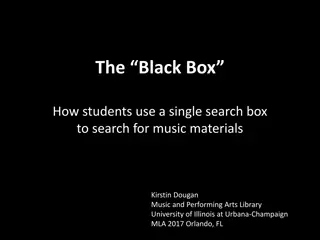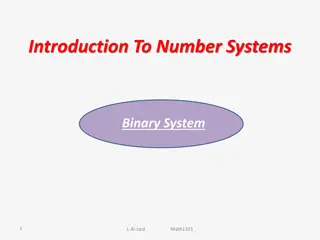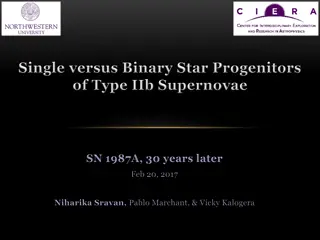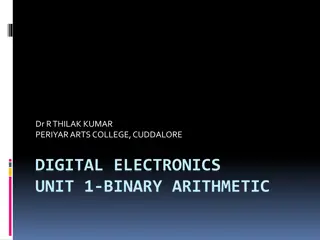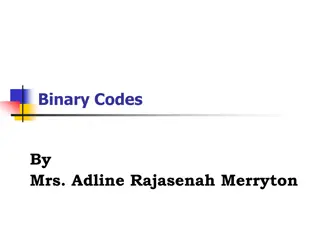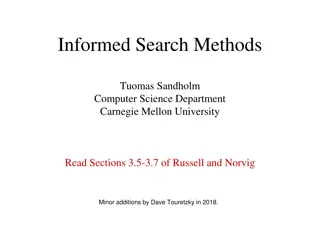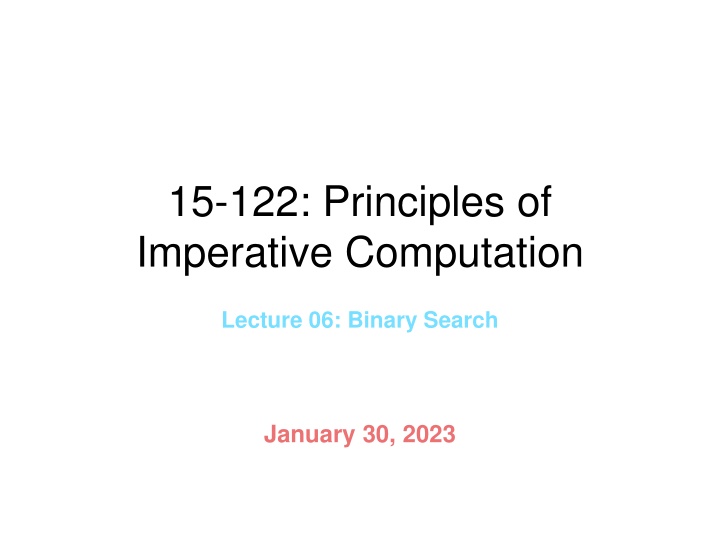
Principles of Imperative Computation Lecture 06: Binary Search Overview
Explore the concepts covered in lecture 06 of the "Principles of Imperative Computation" series, focusing on binary search algorithm, implementation, safety proofs, correctness proofs, and the advantages of logarithmic complexity. Understand the differences between linear search and binary search, with insights on searching arrays and optimizing search efficiency on sorted arrays. Dive into the world of computational complexity and enhance your understanding of search algorithms.
Download Presentation

Please find below an Image/Link to download the presentation.
The content on the website is provided AS IS for your information and personal use only. It may not be sold, licensed, or shared on other websites without obtaining consent from the author. If you encounter any issues during the download, it is possible that the publisher has removed the file from their server.
You are allowed to download the files provided on this website for personal or commercial use, subject to the condition that they are used lawfully. All files are the property of their respective owners.
The content on the website is provided AS IS for your information and personal use only. It may not be sold, licensed, or shared on other websites without obtaining consent from the author.
E N D
Presentation Transcript
15-122: Principles of Imperative Computation Lecture 06: Binary Search January 30, 2023
Today Last lecture: Complexity Cost functions, comparing cost functions, Big O, complexity classes, and complexity of linear search Today s lecture: Binary search Algorithm, implementation, safety and correctness proofs, and the logarithmic advantage Announcements: Grades of written assignment 2 are out Programming assignment 3 is due on Wed, Feb 01 by 9:00PM 1
Linear Search Go through the array position by position until we find x int search(int x, int[] A, int n) //@requires n == \length(A); /*@ensures (\result == -1 && !is_in(x, A, 0, n)) || (0 <= \result && \result < n && A[\result] == x); @*/ { for (int i = 0; i < n; i++) { if (A[i] == x) return i; } return -1; } Loop invariants omitted Worst case complexity: O(n) 3
Linear Search on Sorted Arrays Stop early if we find an element greater than x int search(int x, int[] A, int n) //@requires n == \length(A); //@requires is_sorted(A, 0, n); /*@ensures (\result == -1 && !is_in(x, A, 0, n)) || (0 <= \result && \result < n && A[\result] == x); @*/ { for (int i = 0; i < n; i++) { if (A[i] == x) return i; if (x < A[i]) return -1; //@assert A[i] < x; } return -1; } Worst case complexity: still O(n) o E.g., If x is larger than any element in A 4
Can We Do Better on Sorted Arrays? Look in the middle! o Compare the midpoint element with x o If found, great! o If x is smaller, look for x in the lower half o If x is bigger, look for x in the upper half This algorithm is referred to as binary search Why better? o We are throwing out half of the array each time! With linear search, we were throwing out just one element! o If array has length n, we can halve it only log n times 5
A Cautionary Tale Jon Bentley Only 10% of programmers can write binary search o 90% had bugs! Binary search dates back to 1946 (at least) o First correct description in 1962 Jon Bentley wrote the definitive binary search and proved it correct Jon Bentley, Algorithms professor at CMU in the 1980s Read more at https://reprog.wordpress.com/2010/04/19/are- you-one-of-the-10-percent/ 6
More of a Cautionary Tale Joshua Bloch Joshua Bloch found a bug in Jon Bentley s definitive binary search! o That Bentley had proved correct!!! Joshua Bloch, Student of Jon Bentley Worked at Google Occasionally adjunct Prof. at CMU Went on to implementing several searching and sorting algorithms used in Android, Java, and Python o E.g., TimSort Read more at https://ai.googleblog.com/2006/06/extra-extra-read-all- about-it-nearly.html 7
Even More of a Cautionary Tale Researchers found a bug in Joshua Bloch s code for TimSort o Implemented it in a language with contracts (JML Java Modelling Language) o Tried to prove correctness using KeY theorem prover Some of the same contract mechanisms as C0 (and a few more) (we borrowed our contracts of them) Read more at http://www.envisage-project.eu/proving-android- java-and-python-sorting-algorithm-is-broken-and- how-to-fix-it/ 8
Is Implementing Binary Search Simple? Implementing binary search is not as simple as it sounds o Many professionals have failed! We want to proceed carefully and methodically Contracts will be our guide! 9
Binary Search 0 1 2 3 4 5 6 7 A: 2 3 5 9 11 13 17 Find midpoint of A[0,7) Index 3 A[3] = 9 0 1 2 3 4 5 6 7 A: 2 3 5 9 11 13 17 A is sorted Looking for x = 4 4 < 9 Ignore A[4,7) Ignore also A[3] 0 1 2 3 4 5 6 7 A: 2 3 5 9 11 13 17 Find midpoint of A[0,3) Index 1 A[1] = 3 0 1 2 3 4 5 6 7 A: 2 3 5 9 11 13 17 3 < 4 Ignore A[0,1) Ignore also A[1] 0 1 2 3 4 5 6 7 2 3 5 9 11 13 17 A: Find midpoint of A[2,3) Index 2 A[2] = 5 0 1 2 3 4 5 6 7 A: 2 3 5 9 11 13 17 4 < 5 Ignore A[3,3) Ignore also A[2] 0 1 2 3 4 5 6 7 A: 2 3 5 9 11 13 17 Nothing left! A[2,2) is empty 4isn t in A 11
lo hi Binary Search 0 1 2 3 4 5 6 7 A: 2 3 5 9 11 13 17 Find midpoint of A[lo,hi) Index mid = 3 A[mid] = 9 mid lo hi 0 1 2 3 4 5 6 7 A: 2 3 5 9 11 13 17 A is sorted At each step, we o Examine a segment A[lo, hi) o Find its midpoint mid o Compare x = 4 with A[mid] 4 < A[mid] Ignore A[mid+1,hi) Ignore also A[mid] hi lo 0 1 2 3 4 5 6 7 A: 2 3 5 9 11 13 17 Find midpoint of A[lo,hi) Index mid = 1 A[mid] = 3 mid lo hi 0 1 2 3 4 5 6 7 A: 2 3 5 9 11 13 17 A[mid] < 4 Ignore A[lo,mid) Ignore also A[mid] lo hi 0 1 2 3 4 5 6 7 2 3 5 9 11 13 17 A: Find midpoint of A[lo,hi) Index mid = 2 A[mid] = 5 lo,mid hi 0 1 2 3 4 5 6 7 A: 2 3 5 9 11 13 17 4 < A[mid] Ignore A[mid+1,hi) Ignore also A[mid] lo,hi 0 1 2 3 4 5 6 7 A: 2 3 5 9 11 13 17 Nothing left! A[lo,hi) is empty 4isn t in A 12
lo hi Binary Search 0 1 2 3 4 5 6 7 A: 2 3 5 9 11 13 17 Find midpoint of A[lo,hi) Index mid = 3 A[mid] = 9 mid lo hi 0 1 2 3 4 5 6 7 A: 2 3 5 9 11 13 17 Let s look for x = 11 At each step, we o Examine a segment A[lo, hi) o Find its midpoint mid o Compare x = 11 with A[mid] A[mid] < 11 Ignore A[lo,mid) Ignore also A[mid] hi lo 0 1 2 3 4 5 6 7 A: 2 3 5 9 11 13 17 Find midpoint of A[lo,hi) Index mid = 5 A[mid] = 13 mid lo hi 0 1 2 3 4 5 6 7 A: 2 3 5 9 11 13 17 11 < A[mid] Ignore A[lo,mid) Ignore also A[mid] lo hi 0 1 2 3 4 5 6 7 2 3 5 9 11 13 17 A: Find midpoint of A[lo,hi) Index mid = 4 A[mid] = 11 lo,mid hi 0 1 2 3 4 5 6 7 A: 2 3 5 9 11 13 17 11 = A[mid] Found! Return 4 13
Setting up Binary Search Same contracts as linear search: different algorithm to solve the same problem int binsearch(int x, int[] A, int n) //@requires n == \length(A); //@requires is_sorted(A, 0, n); /*@ensures (\result == -1 && !is_in(x, A, 0, n)) || (0 <= \result && \result < n && A[\result] == x); @*/ { int lo = 0; int hi = n; while (lo < hi) { } return -1; } lo starts at 0, hi at n bunch of steps returns -1 if x not found 15
What Do We Know at Each Step? At an arbitrary iteration, the picture is: Too small! Too big! If x is in A, it s got to be here 0 lo hi n A: A[0, lo) < x x < A[hi, n) These are candidate loop invariant: o gt_seg(x, A, 0, lo): That is, A[0, lo) < x o lt_seg(x, A, hi, n): That is, x < A[hi, n) o and of course 0 <= lo && lo <= hi && hi <= n 16
hi n 0 lo Adding Loop Invariants A[0, lo) < x x < A[hi, n) int binsearch(int x, int[] A, int n) //@requires n == \length(A); //@requires is_sorted(A, 0, n); /*@ensures (\result == -1 && !is_in(x, A, 0, n)) || (0 <= \result && \result < n && A[\result] == x); @*/ { int lo = 0; int hi = n; while (lo < hi) //@loop_invariant 0 <= lo && lo <= hi && hi <= n; //@loop_invariant gt_seg(x, A, 0, lo); //@loop_invariant lt_seg(x, A, hi, n); { } return -1; } 17
Are these Useful Loop Invariants? hi n 0 lo Can they help prove the postcondition? Is return -1 correct? (assuming invariants are valid) To show: If preconditions are met, then x A[0, n) A. lo hi by line 9 (negation of loop guard) B. lo hi by line 10 (LI 1) C. lo = hi by math on A, B D. A[0,lo) < x by line 11 (LI 2) E. x A[0,lo) by math on D F. x < A[hi,n) by line 12 (LI 3) G. x A[hi,n) by math on F H. x A[0,n) by math on C, E, G A[0, lo) < x x < A[hi, n) 1. int binsearch(int x, int[] A, int n) 2. //@requires n == \length(A); 3. //@requires is_sorted(A, 0, n); 4. /*@ensures (\result == -1 && !is_in(x, A, 0, n)) 5. || (0 <= \result && \result < n && A[\result] == x); @*/ 6. { 7. int lo = 0; 8. int hi = n; 9. while (lo < hi) 10. //@loop_invariant 0 <= lo && lo <= hi && hi <= n; 11. //@loop_invariant gt_seg(x, A, 0, lo); 12. //@loop_invariant lt_seg(x, A, hi, n); 13. { 14. 15. } 16.return -1; 17.} This is a standard EXIT argument 18
Are the Loop Invariants Valid? hi n 0 lo INIT o lo = 0 by line 7 and hi = n by line 8 To show: 0 0 by math To show: 0 n by line 2 (preconditions) and \length To show: n n by math A[0, lo) < x x < A[hi, n) 1. int binsearch(int x, int[] A, int n) 2. //@requires n == \length(A); 3. //@requires is_sorted(A, 0, n); 4. /*@ensures (\result == -1 && !is_in(x, A, 0, n)) 5. || (0 <= \result && \result < n && A[\result] == x); @*/ 6. { 7. int lo = 0; 8. int hi = n; 9. while (lo < hi) 10. //@loop_invariant 0 <= lo && lo <= hi && hi <= n; 11. //@loop_invariant gt_seg(x, A, 0, lo); 12. //@loop_invariant lt_seg(x, A, hi, n); 13. { 14. 15. } 16. //@assert lo == hi; 17. return -1; 18.} To show: A[0, 0) < x To show: x < A[n, n) by math (empty intervals) PRES Trivial o Body is empty o Nothing changes!!! From the correctness proof 19
Is binsearch Correct? EXIT INIT PRES Termination o Infinite loop! 1. int binsearch(int x, int[] A, int n) 2. //@requires n == \length(A); 3. //@requires is_sorted(A, 0, n); 4. /*@ensures (\result == -1 && !is_in(x, A, 0, n)) 5. || (0 <= \result && \result < n && A[\result] == x); @*/ 6. { 7. int lo = 0; 8. int hi = n; 9. while (lo < hi) 10. //@loop_invariant 0 <= lo && lo <= hi && hi <= n; 11. //@loop_invariant gt_seg(x, A, 0, lo); 12. //@loop_invariant lt_seg(x, A, hi, n); 13. { 14. 15. } 16. //@assert lo == hi; 17. return -1; 18.} Let us implement what happens in a binary search step o Compute the midpoint o Compare its value to x 20
int binsearch(int x, int[] A, int n) //@requires n == \length(A); //@requires is_sorted(A, 0, n); /*@ensures (\result == -1 && !is_in(x, A, 0, n)) || (0 <= \result && \result < n && A[\result] == x); @*/ { int lo = 0; int hi = n; while (lo < hi) //@loop_invariant 0 <= lo && lo <= hi && hi <= n; //@loop_invariant gt_seg(x, A, 0, lo); //@loop_invariant lt_seg(x, A, hi, n); { int mid = (lo + hi) / 2; Adding the Body by high-school math if (A[mid] == x) return mid; if (A[mid] < x) { lo = mid + 1; } else { //@assert A[mid] > x; hi = mid; } } //@assert lo == hi; return -1; } if A[mid] not == x and not < x, then A[mid] > x 21
1. int binsearch(int x, int[] A, int n) 2. //@requires n == \length(A); 3. //@requires is_sorted(A, 0, n); 4. /*@ensures @*/ 5. { 6. int lo = 0; 7. int hi = n; 8. while (lo < hi) 9. //@loop_invariant 0 <= lo && lo <= hi && hi <= n; 10. //@loop_invariant gt_seg(x, A, 0, lo); 11. //@loop_invariant lt_seg(x, A, hi, n); 12. { 13. int mid = (lo + hi) / 2; 14. //@assert lo <= mid && mid < hi; // Added 15. if (A[mid] == x) return mid; 16. if (A[mid] < x) { 17. lo = mid + 1; 18. } else { //@assert A[mid] > x; 19. hi = mid; 20. } 21. } 22. //@assert lo == hi; 23. return -1; 24.} Is it Safe? A[mid] must be in bounds o 0 mid < \length(A) mid 0 lo hi n A: A[0, lo) < x x < A[hi, n) We expect lo mid < hi o Notmid hi Otherwise, we could have mid == \length(A) by lines 2, 9 Candidate assertion: lo <= mid && mid < hi o We will check it later 22
1. int binsearch(int x, int[] A, int n) 2. //@requires n == \length(A); 3. //@requires is_sorted(A, 0, n); 4. /*@ensures @*/ 5. { 6. int lo = 0; 7. int hi = n; 8. while (lo < hi) 9. //@loop_invariant 0 <= lo && lo <= hi && hi <= n; 10. //@loop_invariant gt_seg(x, A, 0, lo); 11. //@loop_invariant lt_seg(x, A, hi, n); 12. { 13. int mid = (lo + hi) / 2; 14. //@assert lo <= mid && mid < hi; // Added 15. if (A[mid] == x) return mid; 16. if (A[mid] < x) { 17. lo = mid + 1; 18. } else { //@assert A[mid] > x; 19. hi = mid; 20. } 21. } 22. //@assert lo == hi; 23. return -1; 24.} Are the LI Valid? INIT:Unchanged PRES To show: If 0 lo hi n, then 0 lo hi n o If A[mid] == x, nothing to prove o If A[mid] < x A. lo = mid+1 by line 17 (unchanged) by line 9 (LI1) by line 14 (to be checked) by line 14 (to be checked) by math on E by A, C, D, F by math on A, B, E by B and assumption B. hi = hi C. 0 lo D. lo mid E. mid < hi F. mid < mid+1 G. 0 lo H. lo hi I. hi n o If A[mid] > x Left as exercise 23
1. int binsearch(int x, int[] A, int n) 2. //@requires n == \length(A); 3. //@requires is_sorted(A, 0, n); 4. /*@ensures @*/ 5. { 6. int lo = 0; 7. int hi = n; 8. while (lo < hi) 9. //@loop_invariant 0 <= lo && lo <= hi && hi <= n; 10. //@loop_invariant gt_seg(x, A, 0, lo); 11. //@loop_invariant lt_seg(x, A, hi, n); 12. { 13. int mid = (lo + hi) / 2; 14. //@assert lo <= mid && mid < hi; // Added 15. if (A[mid] == x) return mid; 16. if (A[mid] < x) { 17. lo = mid + 1; 18. } else { //@assert A[mid] > x; 19. hi = mid; 20. } 21. } 22. //@assert lo == hi; 23. return -1; 24.} Are the LI Valid? PRES (continued) To show: If A[0, lo) < x, then A[0, lo ) < x o If A[mid] == x, nothing to prove o If A[mid] < x A. lo = mid+1 B. A[0,n) sorted by line 17 by line 3 C. A[0,mid) A[mid] by B D. A[0, mid+1) < x o If A[mid] > x A. lo = lo by math on C and line 16 (unchanged) by assumption B. A[0,lo) < x To show: If x < A[hi, n), then x < A[hi , n) Left as exercise 24
1. int binsearch(int x, int[] A, int n) 2. //@requires n == \length(A); 3. //@requires is_sorted(A, 0, n); 4. /*@ensures @*/ 5. { 6. int lo = 0; 7. int hi = n; 8. while (lo < hi) 9. //@loop_invariant 0 <= lo && lo <= hi && hi <= n; 10. //@loop_invariant gt_seg(x, A, 0, lo); 11. //@loop_invariant lt_seg(x, A, hi, n); 12. { 13. int mid = (lo + hi) / 2; 14. //@assert lo <= mid && mid < hi; // Added 15. if (A[mid] == x) return mid; 16. if (A[mid] < x) { 17. lo = mid + 1; 18. } else { //@assert A[mid] > x; 19. hi = mid; 20. } 21. } 22. //@assert lo == hi; 23. return -1; 24.} Does it Terminate? The quantity hi-lo decreases in an arbitrary iteration of the loop and never gets smaller than 0 o This is the usual operational argument We can also give a point-to argument To show: If 0 < hi - lo, then 0 hi - lo < hi - lo o If A[mid] == x, nothing to prove o If A[mid] < x A. hi - lo = hi - (mid+1) < hi - mid C. hi - lo D. hi - lo = hi - (mid+1) (mid+1) - (mid+1) = 0 o If A[mid] > x by line 17 (and hi by math by line 14 (to be checked) unchanged) B. by lines 17, 16, 14 and math Left as exercise 25
The Midpoint Assertion int mid = (lo + hi) / 2; //@assert lo <= mid && mid < hi; by high-school math We need to show that lo <= mid && mid < hi Linux Terminal but is it true? o We expect mid == int_max() - 1 == 2147483646 o But we got mid == -2 !!!! lo + hi overflows! # coin -l util --> int lo = int_max() - 2; lo is 2147483645 (int) --> int hi = int_max(); hi is 2147483647 (int) --> int mid = (lo + hi) / 2; mid is -2 (int) Counterexample This is Jon Bentley s bug! o Google was the first company to need arrays that big and Joshua Bloch worked there 26
The Midpoint Assertion Can we compute the midpoint without overflow? int mid = lo + (hi - lo) / 2; //@assert lo <= mid && mid < hi; Joshua Bloch s fix o Does it work? Left as exercise Show that (lo + hi) / 2 is mathematically equal to lo + (hi - lo) / 2 Show that lo + (hi - lo) / 2 never overflows for lo hi What about int mid = lo / 2 + hi / 2? o Never overflows, o But not mathematically equal to (lo + hi) / 2 Left as exercise 27
int binsearch(int x, int[] A, int n) //@requires n == \length(A); //@requires is_sorted(A, 0, n); /*@ensures (\result == -1 && !is_in(x, A, 0, n)) || (0 <= \result && \result < n && A[\result] == x); @*/ { int lo = 0; int hi = n; while (lo < hi) //@loop_invariant 0 <= lo && lo <= hi && hi <= n; //@loop_invariant gt_seg(x, A, 0, lo); //@loop_invariant lt_seg(x, A, hi, n); { int mid = lo + (hi - lo) / 2; //@assert lo <= mid && mid < hi; if (A[mid] == x) return mid; if (A[mid] < x) { lo = mid + 1; } else { //@assert A[mid] > x; hi = mid; } } //@assert lo == hi; return -1; } Final Code for binsearch Safe Correct 28
int binsearch(int x, int[] A, int n) //@requires n == \length(A); { int lo = 0; int hi = n; while (lo < hi) { int mid = lo + (hi - lo) / 2; Complexity of Binary Search Given an array of size n, o We halve the segment considered at each iteration o We can do this at most log n times before hitting the empty array if (A[mid] == x) return mid; if (A[mid] < x) { lo = mid + 1; } else { hi = mid; } } return -1; } Each iteration has constant cost Contracts omitted Complexity of binary search is O(log n) 29
Is O(log n) a Big Deal? Just some boring functions we learned in math classes? What does log n mean in practice? 31
Visualizing Linear and Binary Search Binary Search O(log n) Linear Search O(n) 32
Visualizing Linear and Binary Search m 2m m = log n 33
Drawing for small values of m 4 5 6 7 8 9 10 What have you noticed? 34
Searching with Ants Place items 1 cm apart Horizontally Vertically Ant walks 1cm/s m sec sec 2m sec sec 35
Searching 1000 items with Ants 210 cm 10 m 17 minutes 10 seconds better 36
1 Million Items 20 cm 220 cm 10 km 12 days 20 seconds 37
2 Billion 31 cm 231 cm 20,000 km way better! 63 years 31 seconds 38
35 Billion Items 35 cm 235 cm 376,289 km forget about it 35 seconds 39
To the Sun 44 cm 244 cm 149,600,000 km 44 seconds 40
To the Next Star 62 cm 262 cm 4.24 light-years Proxima Centauri 62 seconds 41
To the Next Galaxy 74 cm 274 cm 25,000 light-years Canis Major Dwarf 74 seconds 42
The Observable Universe 96 cm 296 cm 92 billion light-years 96 seconds 43
All the Atoms in the Universe 265 cm 1080 cm 265 seconds 44
Is O(log n) a Big Deal? YES Constant for practical purposes o It takes just 265 steps to search all atoms in the universe! log n is really neat if you are a computer scientist! 45


